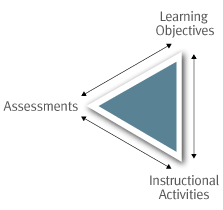Design & Teach a Course
Align Assessments with Objectives
 Assessments should provide us, the instructors, and the students with evidence of how well the students have learned what we intend them to learn. What we want students to learn and be able to do should guide the choice and design of the assessment. There are two major reasons for aligning assessments with learning objectives. First, alignment increases the probability that we will provide students with the opportunities to learn and practice the knowledge and skills that will be required on the various assessments we design. Second, when assessments and objectives are aligned, “good grades” are more likely to translate into “good learning”. When objectives and assessments are misaligned, many students will focus their efforts on activities that will lead to good grades on assessments, rather than focusing their efforts on learning what we believe is important.
Assessments should provide us, the instructors, and the students with evidence of how well the students have learned what we intend them to learn. What we want students to learn and be able to do should guide the choice and design of the assessment. There are two major reasons for aligning assessments with learning objectives. First, alignment increases the probability that we will provide students with the opportunities to learn and practice the knowledge and skills that will be required on the various assessments we design. Second, when assessments and objectives are aligned, “good grades” are more likely to translate into “good learning”. When objectives and assessments are misaligned, many students will focus their efforts on activities that will lead to good grades on assessments, rather than focusing their efforts on learning what we believe is important.
There are many different types of activities that can be used to assess students’ proficiency on a given learning objective, and the same activity can be used to assess different objectives. To ensure more accurate assessment of student proficiencies, it is recommended that you use different kinds of activities so that students have multiple ways to practice and demonstrate their knowledge and skills.
When deciding on what kind of assessment activities to use, it is helpful to keep in mind the following questions:
- What will the student’s work on the activity (multiple choice answers, essays, project, presentation, etc) tell me about their level of competence on the targeted learning objectives?
- How will my assessment of their work help guide students’ practice and improve the quality of their work?
- How will the assessment outcomes for the class guide my teaching practice?
This table presents examples of the kinds of activities that can be used to assess different types of learning objectives, and the ways that we can analyze or measure performance to produce useful feedback for teaching and learning. The categorization of learning objectives is taken from the revised Bloom’s Taxonomy.
| Type of Learning Objective | Examples of Types of Assessment | How to Measure |
|---|---|---|
| Remember Students will be able to:
|
|
|
| Understand Students will be able to:
|
Papers, oral/written exam questions, problems, class discussions, concept maps, homework assignments that require (oral or written):
|
Scoring or performance rubrics that identify critical components of the work and discriminates between differing levels of proficiency in addressing the components |
| Apply Students will be able to:
|
Activities that require students to use procedures to solve or complete familiar or unfamiliar tasks; may also require students to determine which procedure(s) are most appropriate for a given task. Activities include: Problem sets, performances, labs, Prototyping, Simulations |
Accuracy scores, Check lists, Rubrics, Primary Trait Analysis |
| Analyze Students will be able to:
|
Activities that require students to discriminate or select relevant from irrelevant parts, determine how elements function together, or determine bias, values or underlying intent in presented materials. These might include: Case studies, Critiques, Labs, Papers, Projects, Debates, Concept Maps, |
|
| Evaluate Students will be able to:
|
A range of activities that require students to test, monitor, judge or critique readings, performances, or products against established criteria or standards. These activities might include: Journals, Diaries, Critiques, Problem Sets, Product Reviews, Case Studies. |
|
| Create Students will be able to:
|
Research projects, musical compositions, performances, essays, business plans, website designs, prototyping, set designs |
|